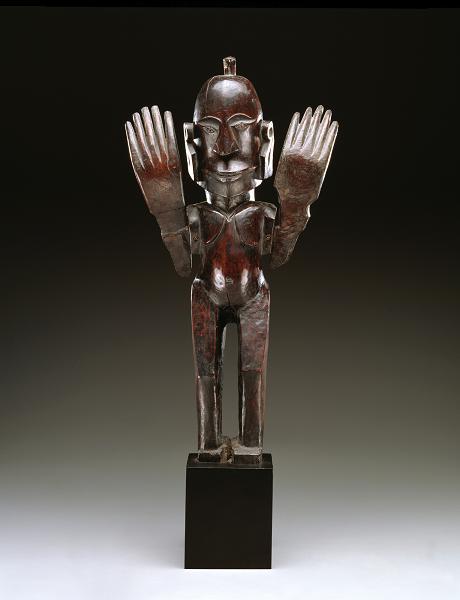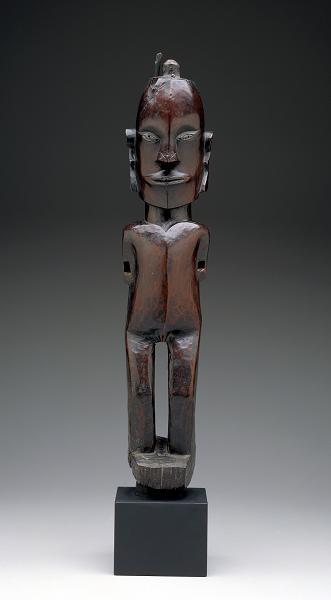My colleague Amy Copeland and I recently led a teaching session focused on a few works of art in the Dallas Museum of Art’s amazing Indonesian collections. Our session in the galleries highlighted an expressive ancestral couple and a beautifully carved door with mythical creatures, emphasizing ways to look closely as well as explore geography and belief systems through objects from Indonesia.
Spirits abound in Indonesia. A mysterious energy animates the entire universe. Human beings and animals, trees and plants, the ancestral dead, stones, man-made objects, even traditional houses — all share in this vital force. Man has been inspired to give many of these spirits tangible form, to make the unseen visible.
— Dallas Museum of Art wall text

Female ancestor figure, Toba Batak people, Sumatra, Indonesia, 19th century or earlier, wood, Dallas Museum of Art, the Eugene and Margaret McDermott Art Fund, Inc.

Male ancestor figure, Toba Batak people, Sumatra, Indonesia, 19th century or earlier, wood, Dallas Museum of Art, the Eugene and Margaret McDermott Art Fund, Inc.
This male and female pair represents an ancestral couple from the Toba Batak peoples on the island of Sumatra. The two objects were originally bound together with a third object and kept out of sight in the uppermost region of the house inhabited by the Batak lineage founder. This region of the house was a space the Batak associated with the upperworld, where gods and ancestors reside. Only a privileged few were ever allowed to view or touch these powerful ancestors who both protected as well as carried the potential to inflict harm. What I love about this couple are their expressive qualities. Look closely at their faces — the eyes, the noses, and the mouths. Next, notice their posture. Both have knees bent slightly and their backs held in a certain way. Viewing these in the galleries is best so that you can walk all the way around them. Finally, perhaps what attracts our eye most are the large hands of the female. The male once had separately carved hands as well. You can see the rectangular slots on either side where his hands were once attached. The hands on the female are up, with palms turned inward. This gesture expresses the Batak greeting of “Horas”, or hello.

Door with protective symbols, Kayan people, East Kalimantan, Indonesia, c. 1850-1900, wood, brass, and shell, Dallas Museum of Art, the Roberta Coke Camp Fund
The Kayan people of East Kalimantan in Indonesia live in longhouses, which can be very large structures that rise from the ground on stilts. The longhouse is a series of contiguous, individual spaces connected by a common verandah. The organization of the spaces in the longhouse is similar to the American concept of apartment structures. Each space houses a family, so a longhouse is the residence for many people. This wooden door was either as the main door to the longhouse or as the door to the individual space of the chief. The animal symbols carved on the door protected inhabitants from evil spirits and intruders. Look closely for animal forms on the door. The white, shell circles contrast sharply with the dark wood. These circles are the eyes of the protective, mythical creature called the aso, a form resembling both a dog and a dragon.
In addition to looking at objects in the galleries, Amy and I shared some general information about Indonesia during the session that help us begin to know and connect with this far away location.
- Indonesia is the largest archipelago in the world! It consists of thousands of islands.
- According to Google Maps, it is 9,200 miles between Dallas, Texas and the East Kalimantan in Indonesia.
- A plane ride to Indonesia would last sixteen to eighteen hours!
- Many islands in Indonesia have been known throughout history for the spices, such as nutmeg, and natural medicines, such as camphor, found there.
- Several delicious coffees originate from Indonesia. Sumatran coffee from the island of Sumatra is one of my favorites.
Nicole Stutzman
Director of Teaching Programs and Partnerships
3 Responses to “Revealing Spirits: The Art of Indonesia”